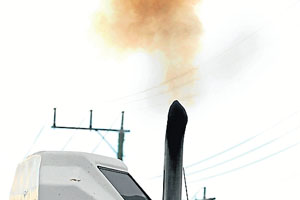By CAMERON LUCADOU-WELLS
WHAT DO YOU THINK? SCROLL TO BELOW THIS STORY TO POST A COMMENT.
A DANDENONG truck operator has downplayed the health risks associated with diesel truck emissions following reports that exhaust from the vehicles can cause cancer.
Last week, a World Health Organisation body, the International Agency for Research on Cancer, ruled that diesel exhaust caused lung cancer. There was also limited evidence of a link to bladder cancer.
The truck operator, who didn’t wish to be named, said the risk was being reduced by improved exhaust control technology that absorbed harmful chemicals.
He said most of his fleet complied with Euro 4 emission standards introduced in 2006 and 2007 and one of his trucks was compliant with Euro 5.
He said trucks less than Euro 4 compliance would not attract the federal government’s diesel tax rebate.
“Any truck owned by the big five operators wouldn’t be more than five years old. There might be a few single operators out there with older trucks. Things are getting better, though you can’t change it all overnight.”
The number of heavy vehicles on Greater Dandenong roads is expected to increase, with its role as a inland freight hub and the expected expansion of Port of Melbourne and Port of Hastings.
Professor Michael Abramson, of Monash University’s school of public health and preventive medicine, said Australia’s regulations on diesel emissions were disappointing.
Professor Abramson said there was “no question” that exhausts from heavy diesel vehicles were adverse to human health.
He nominated heavy diesel vehicles as among the dominant sources of airborne particle pollution, which is linked to heart and lung disease. “There doesn’t seem to be a safe level. The best thing we can do is to try to reduce the amount of air pollution.”
The harmful components included incompletely burnt soot and benzoalphapyrene, a carcinogen also contained in cigarette smoke.
“The big problem is the older vehicles. It is possible to recondition the engines so they can last for thousands of kilometres longer than other cars. The soot builds up in the engine and is then emitted into the air. The most at risk are the drivers themselves.”
The Environment Protection Authority is reviewing its vehicle emissions regulations. Its final report has yet to be handed down.
For all the latest breaking news, visit greaterdandenongweekly.com.au. Follow the Greater Dandenong Weekly on Twitter @DandenongWeekly.







